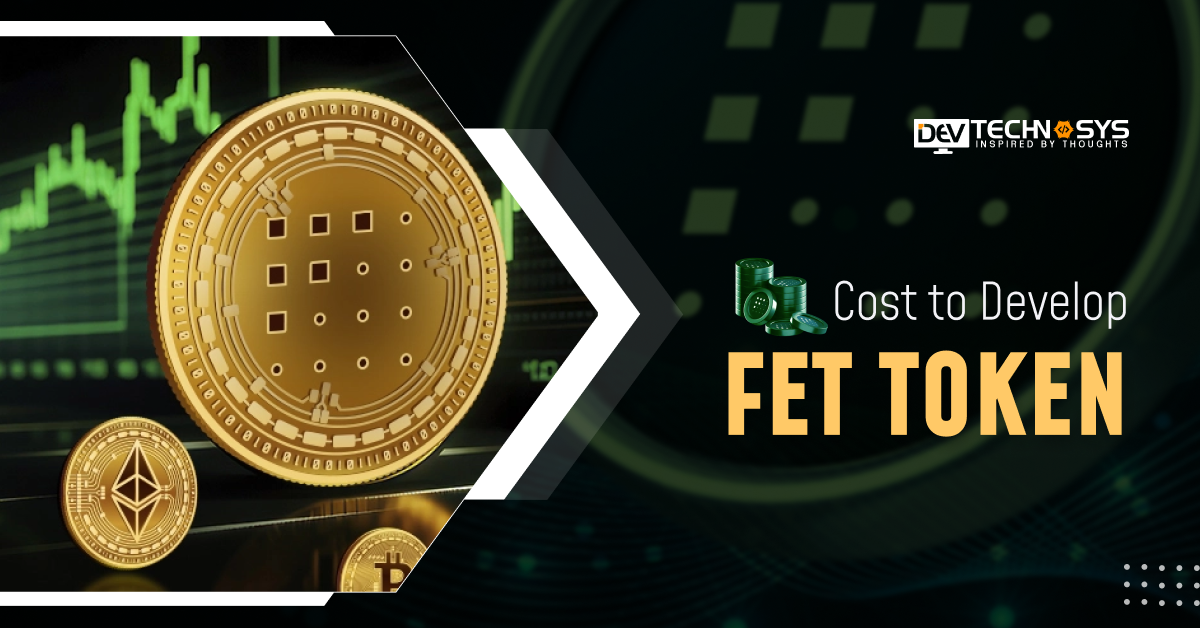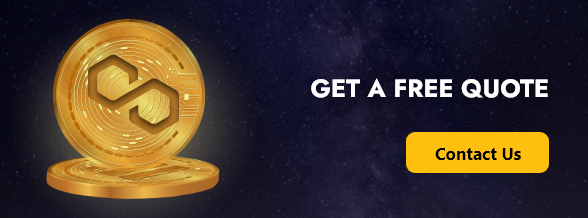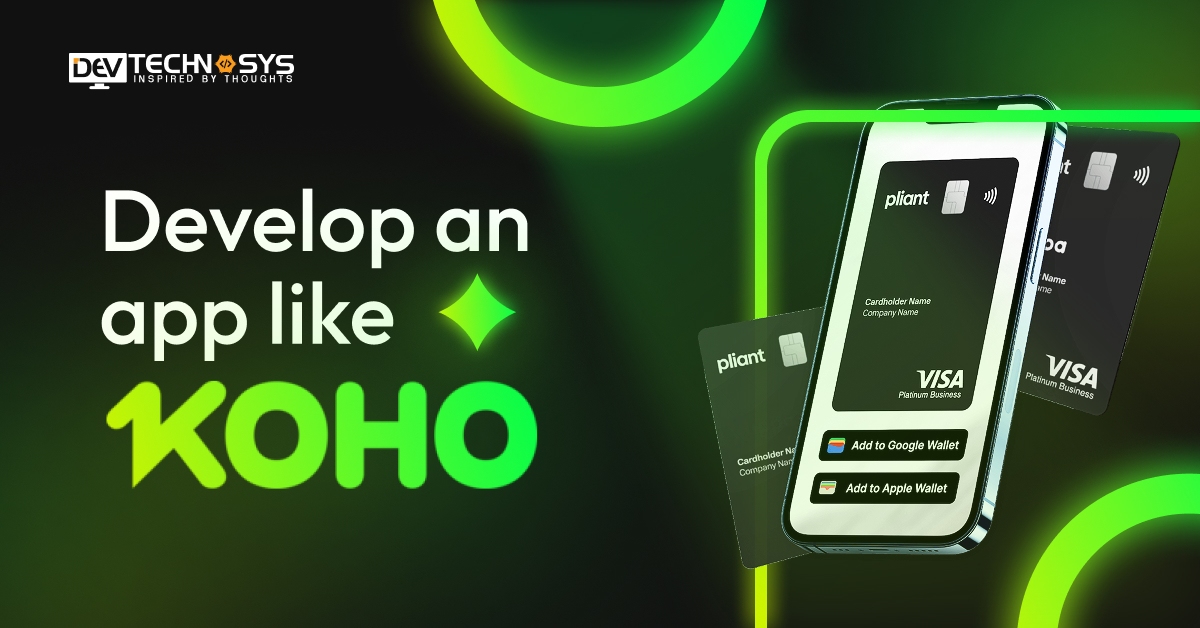“Experience the power of AI in crypto by developing a token like FET.”
The use of general digital crypto currencies like Bitcoin, Ethereum, and others are at its prime. A new mode of tokenization that includes AI as a primary technology is getting popular among people which is known as FET token. For businesses there is only one thing to know that is the cost to develop a FET token with the help of AI and Blockchain.
The introduction of AI-powered coins and tokens has shifted the interests of entrepreneurs towards the combination of multiple technologies for developing a single platform. So, before starting it is necessary to know various factors related to development expenses.
In this blog, we will find out different market restrictions, cost-reducing methods, features, development, benefits, and challenges connected with the development of FET token.
What is a FET Token?
The native cryptocurrency of the Fetch.ai blockchain, a FET Token is intended to support decentralized machine learning and artificial intelligence applications.
In sectors like finance, supply chain, and mobility, it makes smart contracts, self-governing agents, and AI-driven automation possible. FET tokens enable staking for governance and validation, and enable safe peer-to-peer transactions.
They facilitate real-time decision optimization through predictive analytics and data exchange driven by AI. As a decentralized utility token, FET guarantees transparent, trustless interactions inside the Fetch.AI ecosystem, improves the efficiency of the blockchain platform, and lower operation cost. It is essential to the global advancement of blockchain applications powered by AI.
Current Market Stats on Crypto Tokens and Coins
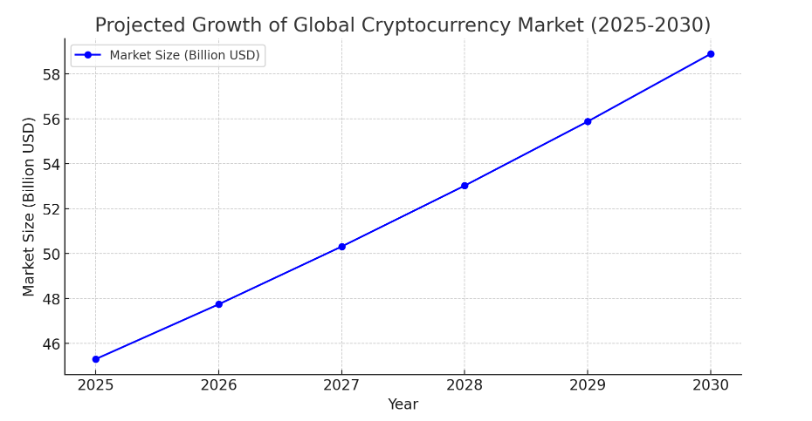
- In 2025, the global cryptocurrency market is expected to generate $45.3 Billion in sales.
- With a compound annual growth rate of 5.39% CAGR between 2025-2030 , it is anticipated to reach a projected total of $45.3 Billion by 2025.
- In 2025, it is projected that the average revenue per user in the cryptocurrency sector will be $52.7.
- The United States is expected to produce the most revenue when compared globally, with $9.4 Billion in 2025.
- It is anticipated that the market for cryptocurrencies would have 861.01 Million users by 2025.
- By 2025, it is anticipated that the user penetration rate will have increased to 11.02%.
- With significant financial institutions and tech firms at the vanguard, the US continues to lead the world in cryptocurrency invention and acceptance despite legal obstacles.
What is the Cost to Develop a FET Token?
A number of business and technical factors affect the cost to develop a FET Token. Every component has an effect on the entire budget, from selecting the blockchain to incorporating smart contracts. The major factors of development costs are listed below:
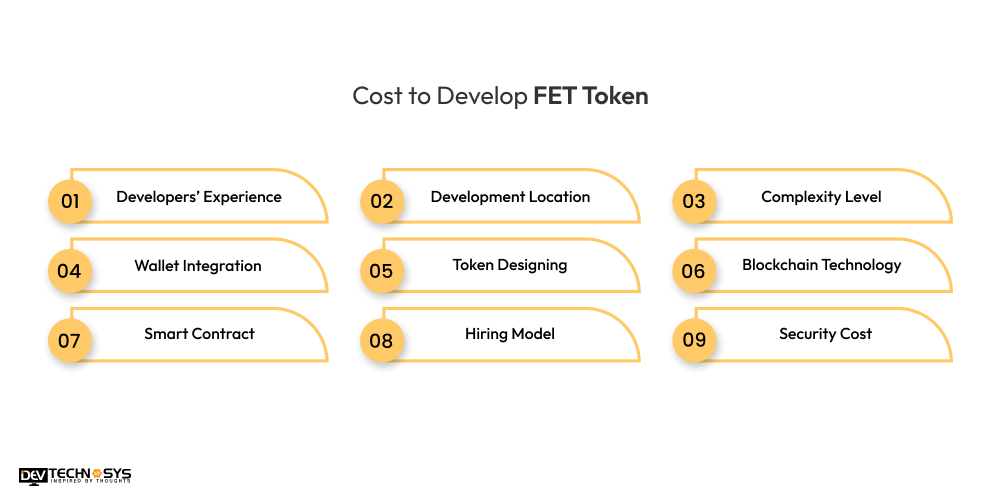
1. Developers’ Experience
Because of their proficiency in Solidity, Rust, and smart contract security, highly qualified blockchain developers command premium prices. Future dangers are decreased by skilled developers that guarantee safe and scalable token development.
Although hiring less experienced developers could reduce the cost to build a FET Token, it could also result in ineffective coding or vulnerabilities.
Expertise Level |
Cost Estimation (USD) |
| Junior/Entry-Level | $2000-$5000 |
| Mid-Level/Experienced | $5000-$8000 |
| Senior/Expert | $8000-$10000 |
| Professional | $10000-$12000 |
2. Development Location
The FET token development cost is greatly impacted by the developers’ geographic location. Compared to developers in Asia or Eastern Europe, those in North America and Western Europe charge higher hourly rates. Although offshore development teams offer affordable alternatives, quality assurance may necessitate additional coordination.
Location Factor |
Estimated Cost |
| USA | $13000-$15000 |
| Australia | $10000-$13000 |
| India | $3000-$5000 |
| UK | $8000-$10000 |
| UAE | $5000-$6000 |
| Brazil | $6000-$8000 |
3. Complexity Level
The cost to build a FET token with conventional functionality is lower than that of a complex one with multi-chain interoperability, staking, or AI automation.
Advanced security procedures and automated contract execution are examples of additional features that raise development costs and effort. The cost of creating a crypto token increases with the complexity of the token features.
Complexity Level |
Development Time |
Estimated Cost |
| Simple | 1-2 months | $1000-$2000 |
| Moderate | 2- months | $2000-$5000 |
| Complex | 3-5 months | $5000-$8000 |
| Premium | More than 5 months | $8000-$10000 |
4. Wallet Integration
The cost to create a FET token is increased when the token is integrated with well-known cryptocurrency wallets like MetaMask, TrustWallet, or custom wallets.
It takes more work and testing to guarantee smooth wallet compatibility for safe transactions. Integration of many wallets on various blockchains can increase the cost to make a FET token.
Wallet Integration |
Estimated Cost |
| Databases | $4,000-$6,000 |
| API Integration | $6,000-$8,000 |
| Crypto Wallet | $8,000-$10,000 |
| Blockchain Framework | $10,000-$12,000 |
5. Token Designing
Strategic planning is needed to design the token’s supply mechanisms, governance structure, and economics. The cost to create a FET Token is affected by variables such as total supply, burning procedures, and staking rewards. While a well-thought-out tokenomics model guarantees sustainability, it necessitates professional technical and financial advice.
Token Designing |
Estimated Cost |
| Token Switching | $2,000-$5,000 |
| Counter Mechanism | $5,000-$8,000 |
| AI-Powered Functions | $8,000-$10,000 |
6. Blockchain Technology
The cost to make a FET token, security, and transaction fees are all impacted by the blockchain selection. Binance Smart Chain (BEP-20) and Cosmos SDK provide more affordable options.
But, Ethereum (ERC-20), which is frequently utilized, has hefty gas prices. So, you must contact an Ethereum development company to configure the cost of creating a crypto token like FET.
Blockchain Technology |
Per Hour Estimated Cost (AED) |
| Ethereum | $2,000-$3,000 |
| Binance Smart Chain | $3,000-$5,000 |
| Cosmos SDK | $5,000-$8,000 |
| Hyperledger Fabric | $8,000-$10,000 |
7. Smart Contract
One of the most important and expensive processes is creating, testing, and implementing secure smart contracts. Expert coding and thorough security assessments are necessary for advanced contract functions like AI-powered automation, self-executing agreements, and governance mechanisms. Smart contracts with poor writing might result in losses, which makes audits more necessary.
Smart Contract |
Per Hour Estimated Cost (AED) |
| Key Generation | $1,500-$2,000 |
| Audit Governance | $2,000-$4,000 |
| 3-Way Handshake Model | $4,000-$8,000 |
8. Hiring Model
Costs vary depending on the recruiting model like in-house teams, freelancers, or contracted blockchain development firms. While agencies charge more for full-stack development with security audits, freelancers offer lower prices but might not have the same level of security experience. A hybrid hiring strategy might strike a balance between price and quality.
Hiring Model |
Estimated Cost |
| In House Team | $1,500-$2,000 |
| Full-Time Freelancers | $2,000-$3,000 |
| Developer Outreach | $3,000-$5,000 |
9. Security Cost
Blockchain security is essential since flaws might result in financial losses and hacking dangers. The cost to launch an IEO gets increased with high security measures.
Approaching companies like CertiK or ConsenSys to conduct smart contract audits guarantees dependability. Adding security features like DDoS protection and multi-signature authentication raises costs even more.
Security Cost |
Per Hour Estimated Cost (AED) |
| DDoS protection | $1,000-$2,000 |
| Crypto Authentication | $2,000-$3,000 |
| Digital Signature | $3,000-$5,000 |
How to Reduce the Cost of Developing FET Token?
Although creating a FET token can be costly, businesses can optimize their budget by implementing cost-cutting measures. Overall cost to develop a FET Token can be decreased by selecting important features and utilizing current technologies:
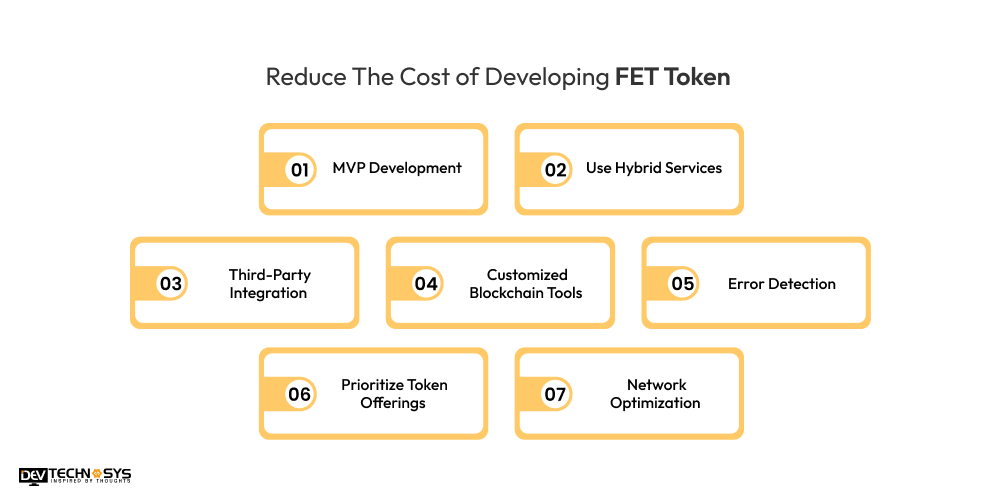
1. MVP Development
Developing a Minimum Viable Product (MVP) facilitates the release of a rudimentary FET token with key features. Based on consumer desire, businesses can hire FET token developers to progressively incorporate new features rather than creating them all at once.
Method |
Percentage Cost Reduction |
| MVP Development | 30% |
2. Use Hybrid Services
Costs can be reduced without sacrificing quality by hiring development teams from a renowned smart contract development company. Companies can retain essential security functions in-house while using offshore developers for more affordable development. Expertise and affordability are balanced through hybrid creation.
Method |
Percentage Cost Reduction |
| Use Hybrid Services | 25% |
3. Third-Party Integration
Costs can be decreased by integrating third-party blockchain services like Infura, Alchemy, or Chain Link rather than creating everything from scratch. Utilizing pre-existing solutions for wallet services, data feeds, and smart contracts reduces infrastructure costs and development time.
Method |
Percentage Cost Reduction |
| Third-Party Integration | 20% |
4. Customized Blockchain Tools
Development costs are decreased by using pre-built blockchain frameworks such as Ethereum, Binance Smart Chain, or Polkadot. Security, scalability, and cost-effectiveness are ensured by utilizing pre-existing platforms with customisation features rather than creating a new blockchain.
Method |
Percentage Cost Reduction |
| Customized Blockchain Tools | 17% |
5. Error Detection
Costly smart contract vulnerabilities can be avoided by spotting and correcting mistakes early in the development process. Using automated testing tools, instituting bug bounty programs, and conducting security audits all aid in identifying problems prior to release.
Method |
Percentage Cost Reduction |
| Error Detection | 15% |
6. Prioritize Token Offerings
Phased launches of security token offerings (STOs) or initial coin offerings (ICOs) aid with cost control. Businesses can obtain capital by targeting DeFi staking platform development solutions in phases according to token demand rather than obtaining full-scale funding up front.
Method |
Percentage Cost Reduction |
| Prioritize Token Offerings | 10% |
7. Network Optimization
Operating costs can be decreased by using FET token development services with lower gas fees, like Binance Smart Chain or Solana. Cost efficiency is increased by using Layer 2 scaling solutions like Polygon and optimizing smart contracts to reduce transaction fees.
Method |
Percentage Cost Reduction |
| Network Optimization | 5% |
Key Features of FET Token
Decentralized AI and automation are made possible by the FET Token, which facilitates effective machine-to-machine communication. The main features are listed below:
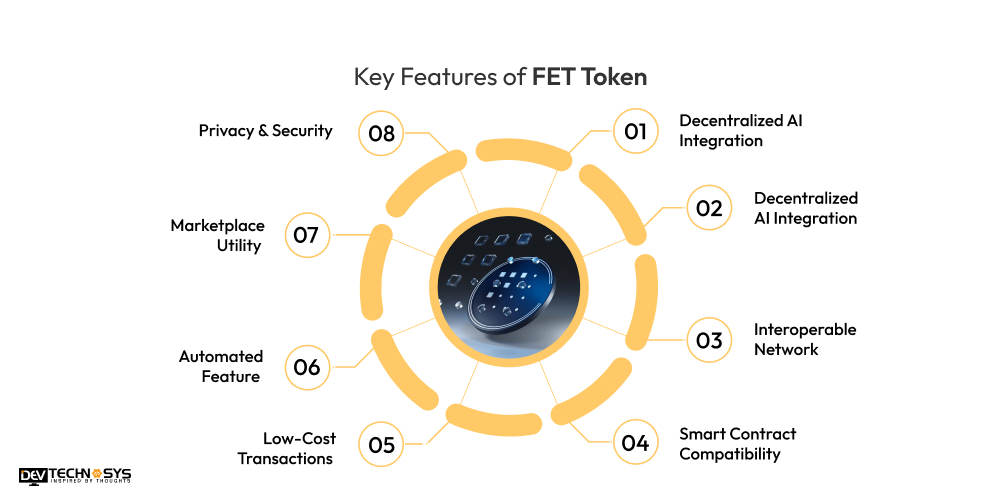
1. Decentralized AI Integration
Smart contracts and autonomous agents can operate together to get FET Token’s support for AI-driven automation on a decentralized network. It improves applications for machine learning without depending on centralized servers.
2. Staking & Governance
Staking on FET Tokens allows users to receive rewards and take part in network decision-making. This feature gives holders control over protocol updates and governance while also assisting with network security.
3. Interoperable Network
High transaction throughput is supported by the blockchain architecture on which FET runs. Use of blockchain technology guarantees smooth interaction with multiple networks, increasing its platform-neutrality.
4. Smart Contract Compatibility
The token’s compatibility with Ethereum-based smart contracts guarantees deployment flexibility for DEX apps. It makes it possible for transactions to be carried out automatically and without middlemen.
5. Low-Cost Transactions
Compared to conventional networks, FET guarantees encrypted, quick, and economical transactions while lowering gas costs. It is therefore perfect for real-time machine interactions and micropayments.
6. Automated Feature
Complex operations like data interchange, supply chain optimization, and financial transactions are carried out by AI-driven autonomous agents like Fetch.ai. Use of FET Tokens improves total efficiency.
7. Marketplace Utility
FET Token makes it easier for consumers to buy, sell, or exchange AI-based services in decentralized marketplaces. In the Fetch.ai ecosystem, it acts as the main exchange channel.
8. Privacy & Security
FET guarantees data security and privacy protection with sophisticated cryptographic algorithms. It shields user data from unwanted access and permits private transactions.
Advanced AI-Based Features of FET Tokens
To improve automation, security, and efficiency in decentralized networks, FET Token incorporates artificial intelligence. Six AI-powered elements that make it unique are listed below:
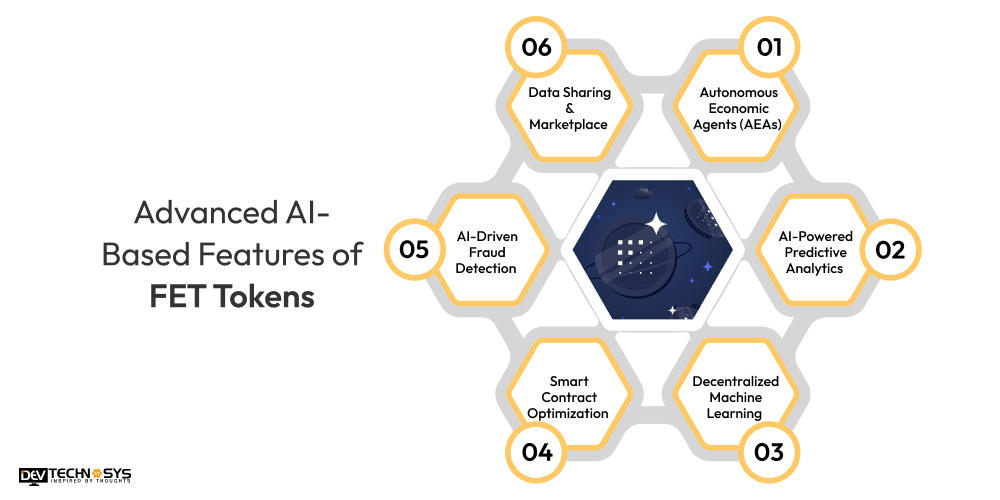
1. Autonomous Economic Agents (AEAs)
AI is used by Fetch.ai’s Autonomous Economic Agents (AEAs) to carry out automated operations like data processing and logistics optimization. They function autonomously and make judgments in real time.
2. AI-Powered Predictive Analytics
AI-driven prediction models for supply chains and financial markets are made possible by FET Token. Large datasets are analyzed by these models to produce precise projections and real-time insights.
3. Decentralized Machine Learning
Collaborative training of AI models without centralized control is made possible via the Fetch.ai network. An AI crypto token platform guarantees privacy-preserving machine learning, where data is kept safe.
4. Smart Contract Optimization
FET uses AI to improve smart contracts, lowering computing costs and increasing speed of execution. Error-free contract deployment and transaction processing are guaranteed by AI-driven automation.
5. AI-Driven Fraud Detection
Fetch.ai uses sophisticated AI algorithms to find abnormalities and questionable activity in blockchain transactions. By strengthening security, this feature stops fraud, scams, and hacking.
6. Data Sharing & Marketplace
AI-powered data-sharing systems enable safe information sharing between individuals and enterprises. The decentralized marketplace Fetch.AI uses AI to match buyers and sellers.
How to Create a FET Token?
Let’s discuss a unified process for developing a FET token. It will help to manage the cost to develop a FET Token and improve your business performance:
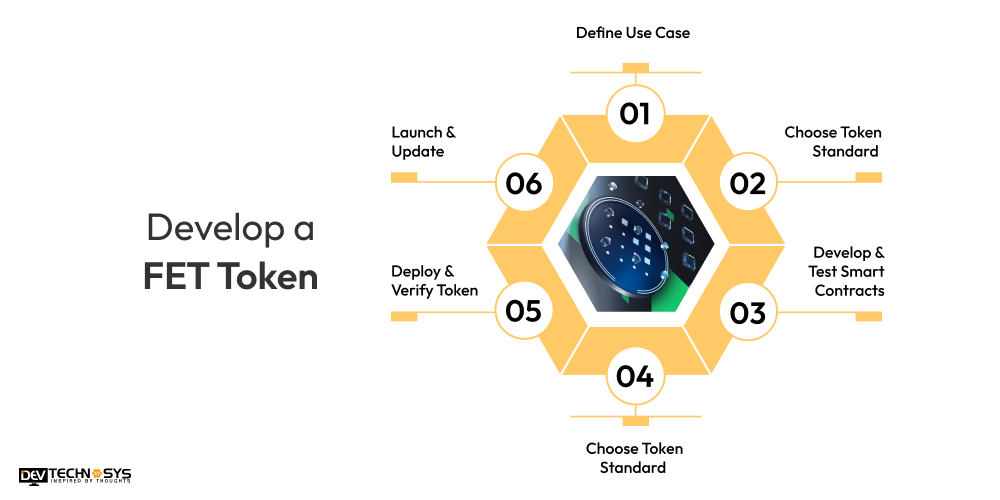
1. Define Use Case
Decide if the token will be used for decentralized transactions, AI-driven automation, or smart contract execution before it is developed. Think of its function in the Fetch.AI ecosystem, like enabling automatic data exchange or promoting machine-to-machine interactions. Clearly defining its use case aids in choosing the appropriate blockchain functionalities and standards.
2. Choose Token Standard
Choosing the right blockchain is essential for high, performance, and security. Networks based on the Ethereum, Binance Smart Chain, or Cosmos SDK provide various benefits.
Businesses should approach a blockchain app development company to determine gas expenses through token standards. Cosmos-based coins improve interoperability with ERC-20 used for smart contracts.
3. Develop & Test Smart Contracts
Smart contracts specify governance procedures, transfer regulations, and token issuance. Smart contracts are typically coded in Solidity (Ethereum) or Rust (Cosmos).
Thorough testing with frameworks such as Hardhat and Truffle guarantees that there are no vulnerabilities. It is beneficial to contact a FET token development company to stop exploits and increase token trust.
4. Integrate AI Features
Incorporate machine learning models for automation if the FET token has AI capabilities. For real-time data processing and smart contract execution, use AI-driven oracles.
Token transactions are optimized and decentralized decision-making is made possible by these features. Automation powered by AI can improve scalability and decrease transaction inefficiencies.
5. Deploy & Verify Token
Deploy the token on the selected blockchain network after development is finished. The deployment process is aided by tools such as Hard Hat and Remix IDE.
To guarantee transparency, confirm the token’s details using dApps development services with explorers like Etherscan or BscScan. Perform small-scale transactions after deployment to confirm functionality and security.
6. Launch & Update
List the token for trading on both centralized and decentralized markets following launch. Widespread acceptance is ensured by creating a robust community through partnerships, marketing, and staking incentives. Establish governance procedures that let people employ decentralized autonomous organizations (DAOs) to influence decisions.
Tech Stack Used For Developing FET Tokens
A strong and expandable technology stack is necessary for creating FET tokens in order to guarantee security, effectiveness, and smooth blockchain integration.
The Fetch.AIecosystem enables decentralized transactions and autonomous economic agents through blockchain and AI. The main elements and related tools utilized in the creation of FET tokens are broken down below:
Components |
Tools |
| Blockchain Platform | Cosmos SDK, Fetch.ai Blockchain |
| Smart Contracts | CosmWasm, Rust |
| Programming Languages | Python, Rust, Go, Solidity |
| Consensus Mechanism | Tendermint Byzantine Fault Tolerance (BFT) |
| Machine Learning (AI) | TensorFlow, PyTorch |
| Decentralized Identity | Self-Sovereign Identity (SSI) |
| Data Storage | IPFS, BigchainDB |
| Networking Protocols | gRPC, REST APIs |
| Security Framework | AES Encryption, Elliptic Curve Cryptography |
| Development Tools | Docker, Kubernetes, GitHub Actions |
Benefits of Developing a FET Token
There are several benefits to creating a FET token, particularly for machine-to-machine communication and decentralized AI-driven ecosystems. The following are six main benefits of developing a FET token:
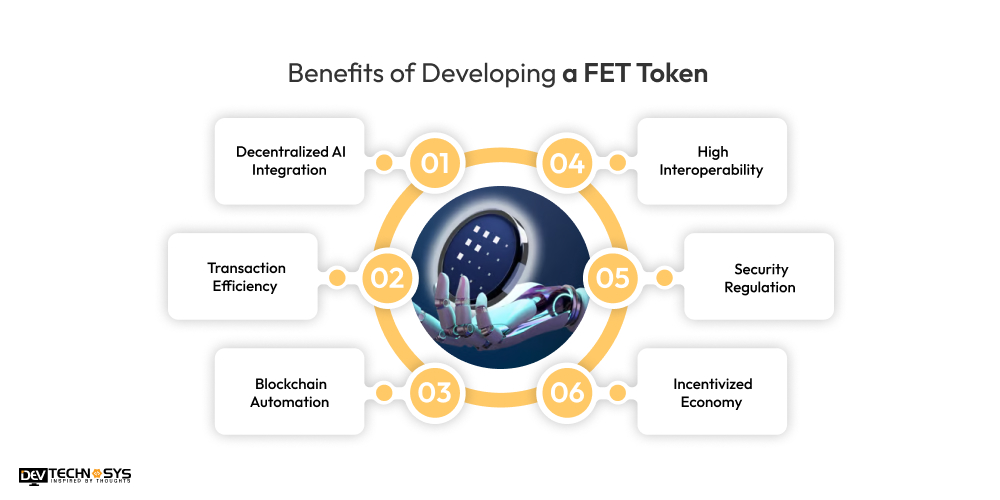
1. Decentralized AI Integration
AI-powered autonomous agents may be seamlessly integrated into decentralized networks thanks to FET tokens. This eliminates the need for centralized control and enables data exchange, automation, and effective machine learning applications.
2. Transaction Efficiency
FET tokens are perfect for micropayments and extensive financial activities since the Fetch.ai blockchain facilitates quick and inexpensive transactions. This guarantees efficiency and scalability across a range of sectors, including supply chain management and finance.
3. Blockchain Automation
Businesses must use smart contract development services with FET tokens to enable AI agent interactions and automated transactions. This improves security and transparency and does away with the need for middlemen in online transactions.
4. High Interoperability
FET tokens, which are based on the Cosmos SDK, provide cross-chain interoperability, facilitating smooth integration with other blockchain networks. This increases the token’s applicability across many ecosystems and platforms.
5. Security Regulation
Strong encryption and privacy-preserving technologies are guaranteed by the FET token ecosystem, safeguarding user information and transaction specifics. Secure and decentralized authentication is made possible by features like self-sovereign identity (SSI).
6. Incentivized Economy
Autonomous AI agents can trade digital goods, resources, and services in an economy powered by Fetch.ai’s FET tokens. To implement decentralized automation businesses must approach a token development company to get from this creative ecosystem.
Major Challenges in Building FET Tokens
Technical challenges and regulatory compliance are just two of the many challenges involved in developing FET tokens. Resolving these issues is essential to guaranteeing scalability, security, and efficiency:
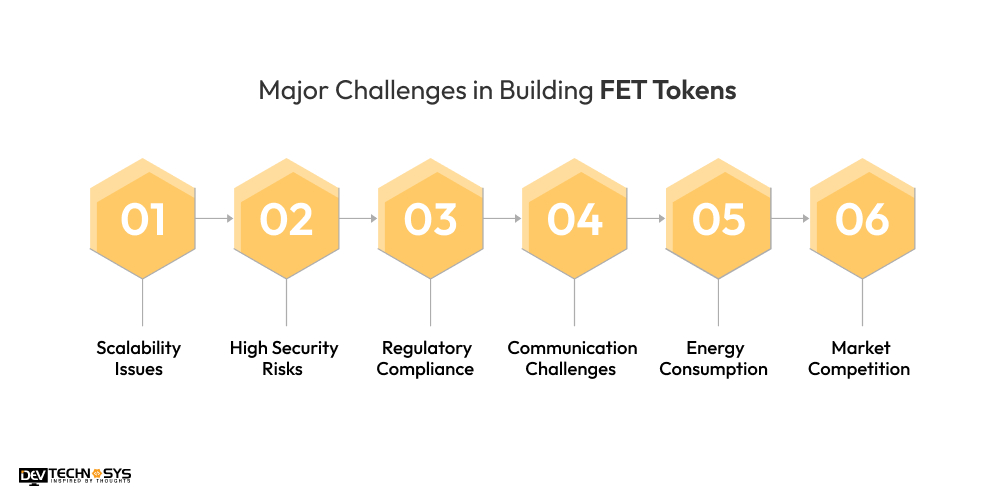
1. Scalability Issues
Efficiency may be impacted by network congestion and slower processing times as transaction volume increases. Performance can also be slowed down by AI-driven operations’ high computing demands.
Solution: Use sharding strategies to increase throughput, optimize consensus processes, and deploy layer-2 scaling solutions.
2. High Security Risks
Smart contract flaws can result in financial losses, hackers, and exploits. System failures and unexpected transactions in the Artificial Intelligence Development process may arise from errors in contract logic.
Solution: Use formal verification techniques, carry out thorough smart contract audits, and incorporate multi-signature authentication for increased security.
3. Regulatory Compliance
With limitations on decentralized financing (DeFi) and cryptocurrency trading in some areas, changing regulatory frameworks might affect the uptake and usability of tokens.
Solution: Establish KYC/AML protocols, collaborate with legal professionals to guarantee regulatory compliance, and adjust to local legislation to prevent legal issues.
4. Communication Challenges
It can be challenging to guarantee smooth integration with both conventional banking systems and other blockchain networks. The usability of the token may be limited by incompatibility.
Solution: To improve interoperability with various blockchain ecosystems, make use of Cosmos SDK, blockchain bridges, and cross-chain protocols.
5. Energy Consumption
High energy usage from AI-powered transactions and mining operations might increase operating expenses and raise environmental issues. It can harm the systems and may disturb the generation of tokens.
Solution: Contacting a cryptocurrency token development company may help you to enhance AI algorithms for reduced resource usage. Use carbon offset plans and implement energy-efficient techniques like Proof-of-Stake (PoS).
6. Market Competition
In a cutthroat cryptocurrency market, gaining acceptance and trust can be challenging, particularly given the abundance of blockchain-based AI solutions already on the market.
Solution: Create solid alliances, engage the community to educate users, and provide special incentives to draw in early adopters and stakeholders.
Let’s Summarize!!
Entrepreneurs must now be happy to know that the cost to develop a FET token can easily be managed by following some precautions. This makes the development process easy and suitable for small crypto business investors as well. Let’s understand some basic points before concluding:
- By managing cost entrepreneurs can easily target FET token development solutions.
- It is easy to approach an affordable Utility token development company for creating FET token clones.
- Money can also be earned by executing preferred monetization strategies.
- Identification of features can help you to reduce the cost to build a FET token.
It is necessary to apply the above checkpoints during the development process. So, businesses can grow without putting extra efforts in the blockchain industry.
Frequently Asked Questions
1. Which are the Most Popular Crypto Tokens in USA?
Bitcoin (BTC), Ethereum (ETH), Binance Coin (BNB), Solana (SOL), and Fetch.ai (FET) are a few of the most well-known cryptocurrency tokens in the United States. These coins are utilized for a variety of decentralized applications and investments, and they are traded extensively.
2. How Long Does it Take to Build FET Tokens?
The complexity, blockchain choice, and feature integration all affect how long it takes to build a FET token. While a fully fledged AI-powered token might take three to six months to build, a basic token can be made in a matter of weeks.
3. How Does FET Tokens Work?
- FET tokens enable AI-driven smart contracts.
- They operate on a blockchain-based decentralized network.
- Fetch.ai tokens support machine learning models.
- Users can utilize FET tokens to earn rewards.
- It facilitates peer-to-peer transactions with lower fees.
4. What is the Cost of Hiring Dedicated Token Developers?
The cost of employing specialized token developers varies according to project complexity, location, and experience. Full-time employment costs for blockchain developers range from $5,000 to $20,000 per month, with an average hourly rate of $25 to $50.
5. What is the Cost to Maintain AI-Based Token Like FET?
Updating smart contracts, conducting security audits, maintaining cloud infrastructure, and paying network fees are all part of maintaining an AI-powered token like FET. Depending on the scope of operations and AI integration, the monthly cost is projected to be between $1,000 and $6,000.
6. Are AI-Powered Tokens Like FET Free to Use?
FET and other AI-powered tokens are not totally free; users may be required to pay subscription fees for premium AI services, transaction fees, or gas fees. While some systems provide free access to their most basic features, more complex AI-based automation frequently costs extra.
